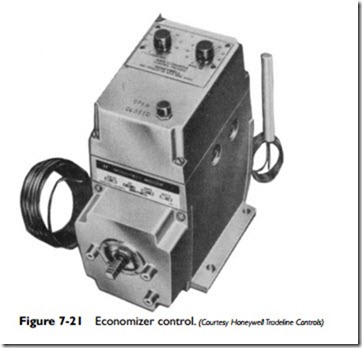Blowers (or Fans) for Duct Systems
The ductwork and blower (or fan) are sized for either heating or cooling (whichever requires the greater air volume); however, their correct sizing depends on an accurate determination of the follow- ing facts about a structure or space:
• The total heat loss
• The total cooling load
• Air delivery required (CFM)
• External static pressure for ductwork
Once these facts are known, it is simply a matter of referring to the performance data provided by the blower or fan manufacturer and selecting the most suitable equipment for the system.
Designing a Duct System
The purpose of a duct system is to convey air from the blower or fan to the air supply outlets located in the various rooms and spaces of the structure, and then to return it to its point of origin.
The design of a duct system is determined by the cfm output of the furnace blower. The size (Btu/h output) of the furnace and its blower is determined by calculating the heat loss for the house or structure. The furnace must have an output capacity capable of replacing the heat loss. The specification sheet for the furnace will list the blower speeds (cfm) and outputs (Btu/h).
Accuracy in estimating the resistance to the flow of air through the duct system is important in the selection of a suitable blower or fan. Resistance should be kept as low as possible in the interest of economy; however, underestimating the resistance will result in the failure of the blower or fan to deliver the required volume of air.
Every precaution should be taken in the design of a duct system to ensure a smooth and efficient flow of air. Careful study should be made of the building drawings with consideration being given to the construction of duct locations and clearances.
The following recommendations may be of use to you in designing a duct system:
• Keep all duct runs as short as possible, bearing in mind that the airflow should be conducted as directly as possible between its source and delivery points, with the fewest possible changes in direction.
• Select location for duct outlets that will ensure proper air distribution. For example, locate the supply outlets in the floors along or near the exterior walls and the returns along or in the interior walls.
• Provide ducts with cross-sectional areas that will permit air to flow at suitable velocities. The furnace blower must have the capacity to overcome the friction between the moving air and the duct surface.
• Use moderate velocities in all ventilating work to avoid waste of power and to reduce noise.
Use lower velocities in schools, churches, theaters, and so on, than in factories and other places where noise due to airflow is not objectionable.
